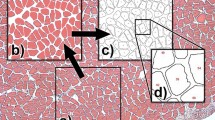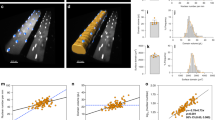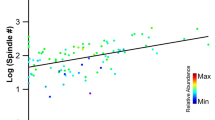Abstract
FAST and slow contracting mammalian muscles differ considerably in their biochemical properties, for example, in their enzyme activity, reflecting especially different quantitative proportions of glycolytic (extramitochondrial) and respiratory (mitochondrial) systems1, ATPase activity of myosin2, ionic content3,4 and many other biochemical characteristics. Avian muscles are especially suitable for the investigation of biochemical differences of fast and slow muscle fibres, as whole muscles consist exclusively of each type of fibre5,6. Little is known of the metabolic differences between fast and slow muscle fibres of birds in which, unlike mammalian muscle fibres, there are also basic structural and electrophysiological differences of fast (phasic) and slow (tonic) muscle fibres, which differ as in frogs according to “fibrillen” or “felderstruktur”5,7, focal or multiple innervation, sensitivity to acetylcholine8 and capacity for long-term contraction9. Both fast and slow contracting mammalian muscles are phasic and do not show such basic structural and electrophysiological differences.
This is a preview of subscription content, access via your institution
Access options
Subscribe to this journal
Receive 51 print issues and online access
$199.00 per year
only $3.90 per issue
Buy this article
- Purchase on Springer Link
- Instant access to full article PDF
Prices may be subject to local taxes which are calculated during checkout
Similar content being viewed by others
References
Czok, R., and Bücher, T., Adv. Prot. Chem., 15, 315 (1960).
Seidel, J. C., Sreter, F. A., Thompson, M. M., and Gergely, J., Biochem. Biophys. Res. Commun., 17, 662 (1964).
Drahota, Z., Physiol. Bohemoslov., 9, 1 (1960).
Drahota, Z., and Gutmann, E., in The Effect of Use and Disuse on Neuromuscular Function (Czechoslovak Academy of Sciences, Prague, 1963).
Krüger, P., in Tetanus und Tonus der Quergestreiften Skelettmuskeln der Wirbeltiere und des Menschen (Leipzig, 1952).
Hess, A., J. Physiol., 157, 221 (1961).
Peachey, L. D., and Huxley, A., J. Cell. Biol., 13, 177 (1962).
Frank, E., Nothmann, M., and Hirsch-Kaufmann, E., Pflüger's Arch. ges. Physiol., 197, 270(1922).
Peachey, L. D., in Biophysics of Physiological and Pharmacological Actions (Amer. Assoc. Adv. Sci., Washington, 1961).
Schmidt, G., and Thanhauser, S. J., J. Biol. Chem., 16l, 83 (1945).
Anson, M. L., J. Gen. Physiol., 22, 79 (1938).
Klicpera, M., Drahota, Z., and Žák, R., Physiol. Bohemoslov., 6, 569 (1957).
Syrový, I., Hájek, I., and Gutmann, E., Physiol. Bohemoslov., 14, 17 (1965).
Author information
Authors and Affiliations
Rights and permissions
About this article
Cite this article
SYROVÝ, I., GUTMANN, E. Metabolic Differentiation of the Anterior and Posterior Latissimus Dorsi of the Chick during Development. Nature 213, 937–938 (1967). https://doi.org/10.1038/213937a0
Published:
Issue Date:
DOI: https://doi.org/10.1038/213937a0
This article is cited by
Comments
By submitting a comment you agree to abide by our Terms and Community Guidelines. If you find something abusive or that does not comply with our terms or guidelines please flag it as inappropriate.



